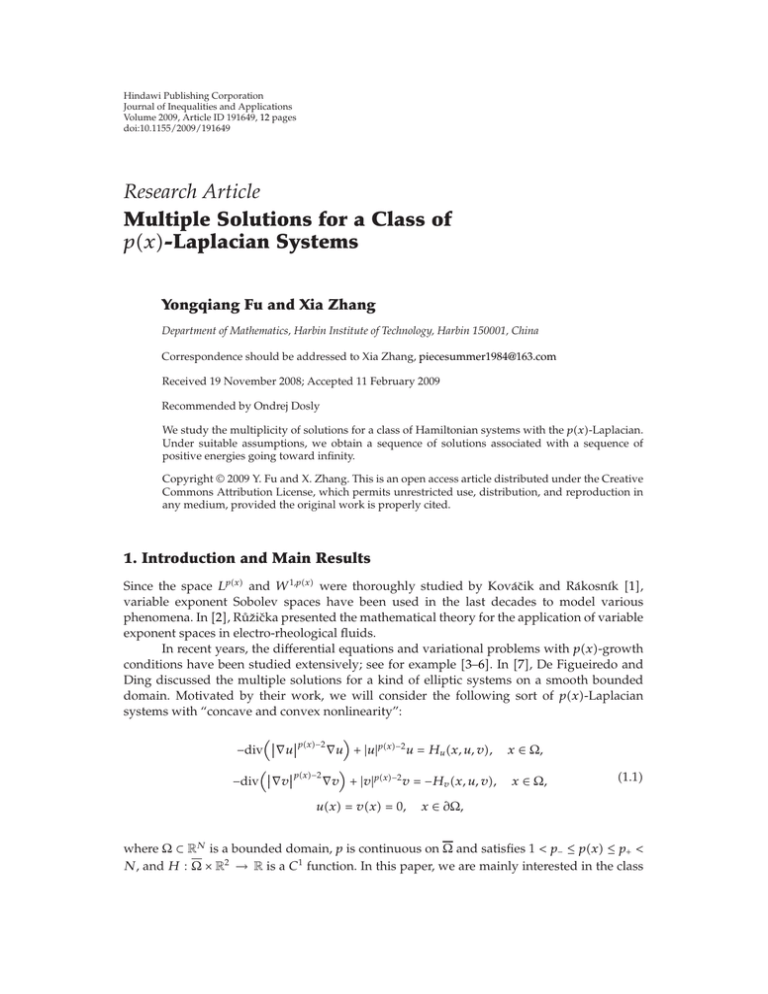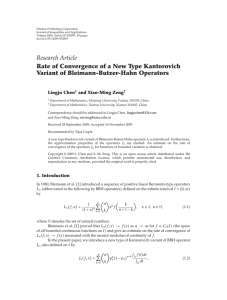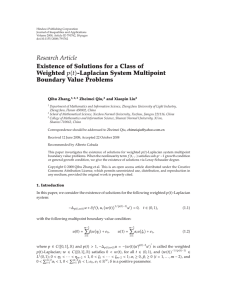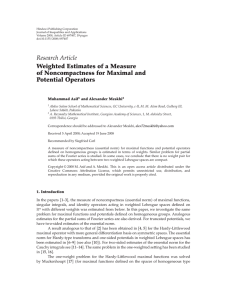Document 10940076
advertisement

Hindawi Publishing Corporation
Journal of Inequalities and Applications
Volume 2009, Article ID 191649, 12 pages
doi:10.1155/2009/191649
Research Article
Multiple Solutions for a Class of
px-Laplacian Systems
Yongqiang Fu and Xia Zhang
Department of Mathematics, Harbin Institute of Technology, Harbin 150001, China
Correspondence should be addressed to Xia Zhang, piecesummer1984@163.com
Received 19 November 2008; Accepted 11 February 2009
Recommended by Ondrej Dosly
We study the multiplicity of solutions for a class of Hamiltonian systems with the px-Laplacian.
Under suitable assumptions, we obtain a sequence of solutions associated with a sequence of
positive energies going toward infinity.
Copyright q 2009 Y. Fu and X. Zhang. This is an open access article distributed under the Creative
Commons Attribution License, which permits unrestricted use, distribution, and reproduction in
any medium, provided the original work is properly cited.
1. Introduction and Main Results
Since the space Lpx and W 1,px were thoroughly studied by Kováčik and Rákosnı́k 1,
variable exponent Sobolev spaces have been used in the last decades to model various
phenomena. In 2, Růžička presented the mathematical theory for the application of variable
exponent spaces in electro-rheological fluids.
In recent years, the differential equations and variational problems with px-growth
conditions have been studied extensively; see for example 3–6. In 7, De Figueiredo and
Ding discussed the multiple solutions for a kind of elliptic systems on a smooth bounded
domain. Motivated by their work, we will consider the following sort of px-Laplacian
systems with “concave and convex nonlinearity”:
px−2
∇u |u|px−2 u Hu x, u, v, x ∈ Ω,
−div ∇u
px−2
∇v |v|px−2 v −Hv x, u, v, x ∈ Ω,
−div ∇v
ux vx 0,
1.1
x ∈ ∂Ω,
where Ω ⊂ RN is a bounded domain, p is continuous on Ω and satisfies 1 < p− ≤ px ≤ p <
N, and H : Ω × R2 → R is a C1 function. In this paper, we are mainly interested in the class
2
Journal of Inequalities and Applications
of Hamiltonians H such that
Hx, u, v |v|βx
|u|αx
Fx, u, v,
αx
βx
1.2
where 1 < α− ≤ αx ≤ px, px βx p∗ x. Here we denote
p sup px,
x∈Ω
p− inf px,
x∈Ω
1.3
and denote by px βx the fact that infx∈Ω βx − px > 0. Throughout this paper,
Fx, u, v satisfies the following conditions:
H1 F ∈ C1 Ω × R2 , R. Writing z u, v, Fx, 0 ≡ 0, Fz x, 0 ≡ 0;
H2 there exist px < q1 x p∗ x, 1 < q2− ≤ q2 x < px such that
Fu x, u, v, Fv x, u, v ≤ a0 1 |u|q1 x−1 |v|q2 x−1 ,
1.4
where a0 is positive constant;
H3 there exist μx, νx ∈ C1 Ω with px μx p∗ x, 1 < ν− ≤ νx ≤ px,
and R0 > 0 such that
1
1
Fu x, u, vu Fv x, u, vv ≥ Fx, u, v > 0,
μx
νx
1.5
when |u, v| ≥ R0 .
As 8, Lemma 1.1, from assumption H3, there exist b0 , b1 > 0 such that
Fx, u, v ≥ b0 |u|μx |v|νx − b1 ,
1.6
for any x, u, v ∈ Ω × R2 . We can also get that there exists b2 > 0 such that
1
1
Fu x, u, vu Fv x, u, vv b2 ≥ Fx, u, v,
μx
νx
1.7
for any x, u, v ∈ Ω × R2 . In this paper, we will prove the following result.
Theorem 1.1. Assume that hypotheses (H1)–(H3) are fulfilled. If Fx, z is even in z, then problem
1.1 has a sequence of solutions {zn } such that
I zn
px px
∇vn px vn px
∇un un −
− H x, zn dx −→ ∞,
px
px
Ω
as n → ∞.
1.8
Journal of Inequalities and Applications
3
2. Preliminaries
First we recall some basic properties of variable exponent spaces Lpx Ω and variable
exponent Sobolev spaces W 1,px Ω, where Ω ⊂ RN is a domain. For a deeper treatment
on these spaces, we refer to 1, 9–11.
Let PΩ be the set of all Lebesgue measurable functions p : Ω → 1, ∞ and
|u|px inf λ > 0 :
px
u
dx ≤ 1 .
Ω λ
2.1
The variable exponent space Lpx Ω is the class of all functions u such that Ω |ux|px dx <
∞. Under the assumption that p < ∞, Lpx Ω is a Banach space equipped with the norm
2.1.
The variable exponent Sobolev space W 1,px Ω is the class of all functions u ∈
px
L Ω such that |∇u| ∈ Lpx Ω and it can be equipped with the norm
u1,px |u|px |∇u|px .
2.2
For u ∈ W 1,px Ω, if we define
|||u||| inf λ > 0 :
Ω
|u|px |∇u|px
dx ≤ 1 ,
λpx
2.3
then |||u||| and u1,px are equivalent norms on W 1,px Ω.
1,px
By W0
Ω we denote the subspace of W 1,px Ω which is the closure of C0∞ Ω
1,px
with respect to the norm 2.2 and denote the dual space of W0
Ω by W −1,p x Ω. We
N
know that if Ω ⊂ R is a bounded domain, ||u||1,px and |∇u|px are equivalent norms on
1,px
W0
Ω.
1,px
Under the condition 1 < p− ≤ p < ∞, W0
space, then there exist
{en }∞
n1
⊂
1,px
W0
Ω
and
Ω is a separable and reflexive Banach
{fm }∞
m1
⊂ W −1,p x Ω such that
1 if n m,
0 if n /
m,
1,px
W0
Ω span ei : i 1, . . . , n, . . . ,
fm en 2.4
W −1,p x Ω span fj : j 1, . . . , m, . . . .
In the following, we will denote that E E1 ⊕ E2 , where
1,px
E1 {0} × W0
Ω,
1,px
E 2 W0
Ω × {0}.
2.5
4
Journal of Inequalities and Applications
For any z ∈ E, define the norm ||z|| ||u, v|| |||u||| |||v|||. For any n ∈ N, set en1 0, en , en2 en , 0 and
Xn span e11 , . . . , en1 ⊕ E2 ,
X n E1 ⊕ span e12 , . . . , en2 ,
2.6
2
2
, en2
, . . .}.
denote the complement of X n in E by X n ⊥ span{en1
3. The Proof of Theorem 1.1
Definition 3.1. We say that z0 u0 , v0 ∈ E is a weak solution of problem 1.1, that is,
∇u0 px−2 ∇u0 ∇u u0 px−2 u0 u − ∇v0 px−2 ∇v0 ∇v
Ω
px−2
− v0 v0 v − Hu x, u0 , v0 u − Hv x, u0 , v0 v dx 0,
3.1
∀z ∈ E.
In this section, we denote that Vm span{ei : i 1, . . . , m}, for any m ∈ N, and ci is
positive constant, for any i 0, 1, 2 . . . .
Lemma 3.2. Any PS sequence {zn } ⊂ E, that is, |Izn | ≤ c and I zn → 0, as n → ∞, is
bounded.
Proof. Let s > 0 be sufficiently small such that l1 infx∈Ω 1/px − 1 s/μx > 0, l2 infx∈Ω 1 s/νx − 1/px > 0, l3 supx∈Ω 1/αx − 1 s/μx > 0, l4 supx∈Ω 1 s/νx − 1/ βx > 0.
Let {zn } ⊂ E be such that |Izn | ≤ c and I zn → 0, as n → ∞. We get
1s
1s
un ,
vn
I zn − I zn ,
μx
νx
px px 1 sun 1 s 1
∇un px−2 ∇un ∇μ
−
un ∇un px
μx
μx2
Ω
1
1s
∇vn px vn px − 1 svn ∇vn px−2 ∇vn ∇ν
−
2
νx
px
νx
1s 1s Fu x, un , vn un Fv x, un , vn vn − F x, un , vn
μx
νx
αx
βx
1
1
1s
1s
un vn −
−
dx
μx
αx
νx
βx
≥
Ω
px
px
αx
βx
l2 ∇vn sF x, un , vn − l3 un l4 vn l1 ∇un px−2
px−2
1 sun 1 svn ∇un
∇vn
∇un ∇μ −
∇vn ∇ν − 1 sb2 dx.
μx2
νx2
3.2
Journal of Inequalities and Applications
5
As μx, νx ∈ C1 Ω, by the Young inequality, we can get that for any ε1 , ε2 ∈ 0, 1,
1 sun ∇un px−2 ∇un ∇μ ≤ c0 ∇un px−1 un 2
μx
1−px
px ε1
px
ε1 px − 1 un ∇un ≤ c0
px
px
px
px 1−p ≤ c0 ε1 ∇un ,
ε un 3.3
1
1 svn ∇vn px−2 ∇vn ∇ν ≤ c1 ε2 ∇vn px ε1−p vn px .
2
νx2
Let ε1 , ε2 be sufficiently small such that
c0 ε1 ≤
l1
,
2
c1 ε2 ≤
l2
,
2
3.4
then
1s
1s
un ,
vn
I zn − I zn ,
μx
νx
px l2 px
νx
l1 μx
∇un ≥
∇vn s b0 un b0 vn − b1
2
2
Ω
px βx
px 1−p 1−p αx
un
vn
l4 vn
− 1 sb2 dx.
− l3 un
c0 ε1
− c1 ε2
3.5
Note that αx ≤ px μx, px βx, by the Young inequality, for any ε3 , ε4 , ε5 ∈ 0, 1,
we get
αx ε3 αxun μx
μx − αx αx/αx−μx
un ε3
≤
μx
μx
μx
−α /μ−α−
≤ ε3 un ε3
,
px ε4 px μx μx − px px/px−μx
un un ε4
≤
μx
μx
μx
−p/μ−p−
≤ ε4 un ε4
,
px ε5 px βx βx − px px/ px−βx
vn vn ε5
≤
βx
βx
βx
−p/ β−p−
≤ ε5 vn ε5
.
3.6
6
Journal of Inequalities and Applications
1−p
Let ε3 , ε4 , ε5 be sufficiently small such that l3 ε3 c0 ε1
get
1−p
ε4 ≤ sb0 and c1 ε2
ε5 ≤ l4 , then we
px l2 px
1s
1s
l1 un ,
vn
∇un
∇vn
I zn − I zn ,
− c2 dx.
≥
μx
νx
2
2
Ω
3.7
Note that
1 s
1 s 1 s 1s
I zn ,
I
≤
·
u
v
u
v
,
z
n
n
n
μx n νx n μx
νx
1s
≤ c3 I zn · ∇
un μx
1s
vn ∇
νx
px
px
≤ c4 I zn · ∇un px ∇vn px ,
3.8
and for n ∈ N being large enough, we have
c4 I zn ≤ min
l1 l2
,
4 4
3.9
.
It is easy to know that if |∇un |px ≥ 1 and |∇vn |px ≥ 1,
∇un px
≤
Ω
∇un px dx,
∇vn px
≤
Ω
∇vn px dx,
3.10
thus we get
I zn ≥
Ω
px l2 px
l1 ∇un
∇vn
− c2 dx,
4
4
3.11
then |∇un |px , |∇vn |px are bounded. Similarly, if |∇un |px < 1 or |∇vn |px < 1, we can also
get that |∇un |px , |∇vn |px are bounded. It is immediate to get that {zn } is bounded in E.
Lemma 3.3. Any PS sequence contains a convergent subsequence.
Proof. Let {zn } ⊂ E be a PS sequence. By Lemma 3.2, we obtain that {zn } is bounded in E.
As E is reflexive, passing to a subsequence, still denoted by {zn }, we may assume that there
Journal of Inequalities and Applications
7
1,px
exists z ∈ E such that zn → z weakly in E. Then we can get un → u weakly in W0
Note that
∇un px−2 ∇un − ∇upx−2 ∇u ∇ un − u
I zn − I z, un − u, 0 Ω
px−2
un un − |u|px−2 u un − u
αx−2
− un un − |u|αx−2 u un − u
− Fu x, un , vn − Fu x, u, v un − u dx.
Ω.
3.12
It is easy to get that
I zn − I z, un − u, 0 −→ 0,
Fu x, u, v un − u dx −→ 0,
3.13
Ω
and un → u in Lpx Ω, un → u in Lαx Ω, as n → ∞. Then
px−2
un un − |u|px−2 u un − u dx −→ 0,
Ω
3.14
αx−2
un un − |u|αx−2 u un − u dx −→ 0,
Ω
as n → ∞. By condition H2, we obtain
Ω
Fu x, un , vn un − u dx
≤
Ω
q x−1 q2 x−1 un − udx
a0 1 un 1
vn q x−1 ≤ a1 un − u1 un 1
q1 x
q x−1 · un − uq1 x vn 2
3.15
q2 x
· un − uq2 x .
It is immediate to get that |un − u|1 → 0, ||un |q1 x−1 |q1 x , ||vn |q2 x−1 |q2 x are bounded and
|un − u|q1 x → 0, |un − u|q2 x → 0, then we get
Ω
Fu x, un , vn un − u dx −→ 0,
∇un px−2 ∇un − ∇upx−2 ∇u ∇ un − u dx −→ 0,
3.16
Ω
as n → ∞. Similar to 3, 4, Theorem 3.1, we divide Ω into two parts:
Ω1 {x ∈ Ω : px < 2},
Ω2 {x ∈ Ω : px ≥ 2}.
3.17
8
Journal of Inequalities and Applications
On Ω1 , we have
Ω1
∇un − ∇upx dx
≤ c5
Ω1
px/ 2
∇un px−2 ∇un − ∇upx−2 ∇u ∇un − ∇u
px px 2−px/2
× ∇un ∇u
dx
px−2 px−2
px / 2 ≤ c6 ∇un ∇un − ∇u
∇u ∇un − ∇u
2/ px ,Ω1
px px 2−px/2 × ∇un ∇u
,
3.18
2/2−px,Ω1
then
Ω1
|∇un − ∇u|px dx → 0. On Ω2 , we have
Ω2
|∇un − ∇u|
dx ≤ c7
|∇un −
Ω
1,px
W0
Ω.
Thus we get
vn → v in
px
Ω2
|∇un |px−2 ∇un − |∇u|px−2 ∇u∇un − ∇udx −→ 0.
1,px
∇u|px dx → 0. Then un → u in W0
3.19
Ω, as n → ∞. Similarly,
Lemma 3.4. There exists Rm > 0 such that Iz ≤ 0 for all z ∈ X m with ||z|| ≥ Rm .
Proof. For any z u, v ∈ X m , u ∈ Vm , we have
Iz ≤
px
∇u
|u|px
px
Ω
px
∇v
|v|px
−
− Fx, u, v dx
px
px
px
∇v
∇u
|u|px
|v|px
μx
≤
−
− b0 |u|
b1 dx.
p−
p
Ω
In the following, we will consider
i If |||u||| ≤ 1. We have
Ω
|∇u|px |u|px /p− − b0 |u|μx dx.
px
∇u
|u|px
Ω
p−
3.20
− b0 |u|
μx
dx ≤
1
.
p−
3.21
ii If |||u||| > 1. Note that μ, p ∈ CΩ, px μx. For any x ∈ Ω, there exists Qx
which is an open subset of Ω such that
px sup py < μx inf μy,
y∈Qx
y∈Qx
3.22
Journal of Inequalities and Applications
9
then {Qx}x∈Ω is an open covering of Ω. As Ω is compact, we can pick a finite subcovering
{Qx}ni1 for Ω. Thus there exists a sequence of open set {Ωi }ni1 such that Ω ni1 Ωi and
pi sup px < μi− inf μx,
3.23
x∈Ωi
x∈Ωi
for i 1, . . . , n. Denote that ri |||u|||Ωi , then we have
px
∇u
|u|px
μx
dx
− b0 |u|
p−
Ω
px
n ∇u
|u|px
μx
− b0 |u|
dx
p−
i1 Ωi
p−
ri >1 Ωi
≤
px
∇u
|u|px
p−
ri ≤1 Ωi
ri >1
− b0 |u|
px
∇u
|u|px
p−
−
dx
3.24
− b0 |u|
p
|||u|||Ωii
μx
μ
b0 kmi |||u|||Ωi−i
μx
dx
n
,
p−
where kmi infu∈Vm |Ωi , |||u|||Ωi 1 Ωi |u|μx dx. As Vm |Ωi is a finite dimensional space, we have
kmi > 0, for i 1, . . . , n.
We denote by si the maximum of polynomial tpi /p− − b0 kmi tμi− on 0, ∞, for i 1, . . . , n. Then there exists t0 > 1 such that
tpi
− b0 kmi tμi− c8 ≤ 0,
p−
3.25
for t > t0 and i 1, . . . , n, where c8 ni1 si n/p− b1 meas Ω.
Let Rm max{2, 2p c8 1/ p− 1 /p− , 2nt0 }. If ||z|| ≥ Rm , we get |||u||| ≥ Rm /2 or
|||v||| ≥ Rm /2.
i If |||u||| ≥ Rm /2, |||u||| ≥ nt0 > 1. It is easy to verify that there exists at least i0 such
that |||u|||Ωi ≥ t0 > 1, thus
0
pi
Iz ≤
|||u|||Ω0i
0
p−
μi
−
− b0 kmi0 |||u|||Ωi0 c8 ≤ 0.
0
3.26
10
Journal of Inequalities and Applications
ii If |||v||| ≥ Rm /2, |||v||| ≥ p c8 1/p− 1/p− . We obtain
Iz ≤ c8 1
|||v|||p−
−
≤ 0.
p−
p
3.27
Now we get the result.
Lemma 3.5. There exist rm > 0 and am → ∞ m → ∞ such that Iz ≥ am , for any z ∈ X m−1 with ||z|| rm .
⊥
⊥
Proof. For z u, v ∈ X m−1 , v 0. By condition H2, there exists c9 > 0 such that
Fx, u, 0 ≤ c9 |u|q1 x c9 .
3.28
Let ||z|| ≥ 1, we get
px
∇u
|u|px
|u|αx
Iz −
− Fx, u, 0 dx
px
αx
Ω
≥
≥
px
∇u
|u|px
p
Ω
px
∇u
|u|px
p
Ω
|u|αx
q1 x
−
− c9 |u|
− c9 dx
α−
3.29
− c10 |u|
q1 x
dx − c11 .
Denote that
θm sup
u∈Vm⊥
Ω
|u|q1 x dx,
3.30
|||u|||≤1
thus
Iz ≥
|||u|||p−
− c10 θm uq1 − c11 .
p
3.31
Let
rm max 1,
p−
c10 p q1 θm
1/q1 −p− 2c11 p q1 1/p−
.
,
q1 − p−
3.32
Journal of Inequalities and Applications
11
By 5, Lemma 3.3, we get that θm → 0, as m → ∞, then
Iz ≥
p
rm−
q1 − p−
p q1
− c11
3.33
am ,
when m is sufficiently large and ||z|| rm . It is easy to get that am → ∞, as m → ∞.
Lemma 3.6. I is bounded from above on any bounded set of X m .
Proof. For z u, v ∈ X m . We get
Iz ≤
px
∇u
|u|px
Ω
px
− Fx, u, v dx.
3.34
By conditions H2 and H3, we know that if |u, v| ≥ R0 , Fx, u, v ≥ 0 and if |u, v| <
R0 , |Fx, u, v| ≤ c0 . Then
px
∇u
|u|px
Iz ≤
c12 dx,
px
Ω
3.35
and it is easy to get the result.
Proof of Theorem 1.1. By Lemmas 3.2–3.6 above, and 7, Proposition 2.1 and Remark 2.1, we
know that the functional I has a sequence of critical values ck → ∞, as k → ∞. Now we
complete the proof.
Acknowledgments
This work is supported by Science Research Foundation in Harbin Institute of Technology
HITC200702 and The Natural Science Foundation of Heilongjiang Province A2007-04.
References
1 O. Kováčik and J. Rákosnı́k, “On spaces Lpx and W k,px ,” Czechoslovak Mathematical Journal, vol.
41116, no. 4, pp. 592–618, 1991.
2 M. Růžička, Electrorheological Fluids: Modeling and Mathematical Theory, vol. 1748 of Lecture Notes in
Mathematics, Springer, Berlin, Germany, 2000.
3 J. Chabrowski and Y. Fu, “Existence of solutions for px-Laplacian problems on a bounded domain,”
Journal of Mathematical Analysis and Applications, vol. 306, no. 2, pp. 604–618, 2005.
4 J. Chabrowski and Y. Fu, “Corrigendum to: “Existence of solutions for px-Laplacian problems on a
bounded domain”,” Journal of Mathematical Analysis and Applications, vol. 323, no. 2, p. 1483, 2006.
5 X. Fan and X. Han, “Existence and multiplicity of solutions for px-Laplacian equations in RN ,”
Nonlinear Analysis: Theory, Methods & Applications, vol. 59, no. 1-2, pp. 173–188, 2004.
6 M. Mihăilescu and V. Rădulescu, “A multiplicity result for a nonlinear degenerate problem arising in
the theory of electrorheological fluids,” Proceedings of the Royal Society of London. Series A, vol. 462, no.
2073, pp. 2625–2641, 2006.
12
Journal of Inequalities and Applications
7 D. G. De Figueiredo and Y. H. Ding, “Strongly indefinite functionals and multiple solutions of elliptic
systems,” Transactions of the American Mathematical Society, vol. 355, no. 7, pp. 2973–2989, 2003.
8 P. L. Felmer, “Periodic solutions of “superquadratic” Hamiltonian systems,” Journal of Differential
Equations, vol. 102, no. 1, pp. 188–207, 1993.
9 D. E. Edmunds, J. Lang, and A. Nekvinda, “On Lpx norms,” Proceedings of the Royal Society of London.
Series A, vol. 455, no. 1981, pp. 219–225, 1999.
10 D. E. Edmunds and J. Rákosnı́k, “Sobolev embeddings with variable exponent,” Studia Mathematica,
vol. 143, no. 3, pp. 267–293, 2000.
11 X. Fan, Y. Zhao, and D. Zhao, “Compact imbedding theorems with symmetry of Strauss-Lions type
for the space W 1,px Ω,” Journal of Mathematical Analysis and Applications, vol. 255, no. 1, pp. 333–348,
2001.







